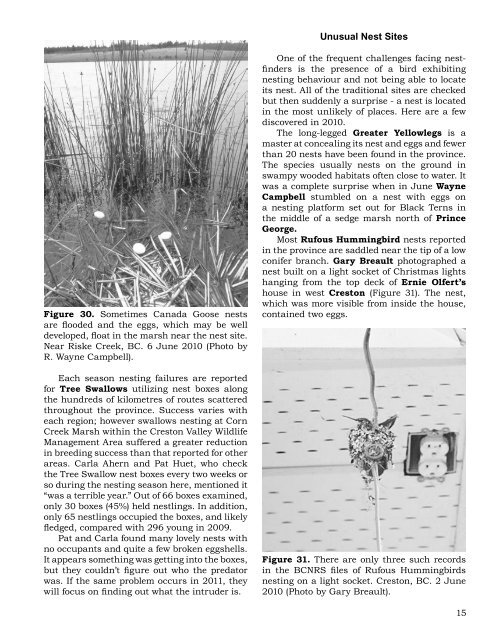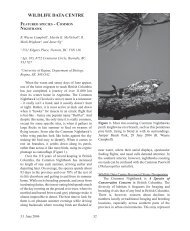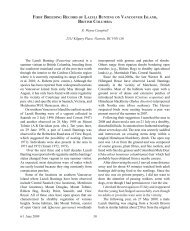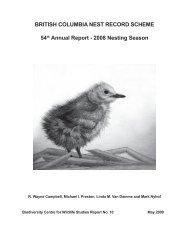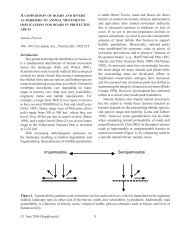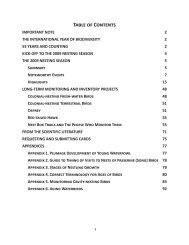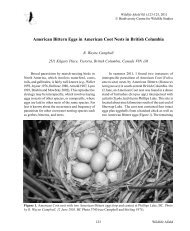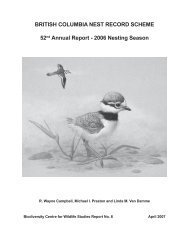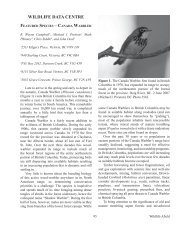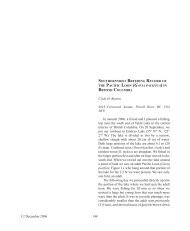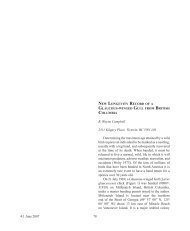2010 Nesting Season - Biodiversity Centre for Wildlife Studies
2010 Nesting Season - Biodiversity Centre for Wildlife Studies
2010 Nesting Season - Biodiversity Centre for Wildlife Studies
Create successful ePaper yourself
Turn your PDF publications into a flip-book with our unique Google optimized e-Paper software.
Unusual Nest Sites<br />
Figure 30. Sometimes Canada Goose nests<br />
are flooded and the eggs, which may be well<br />
developed, float in the marsh near the nest site.<br />
Near Riske Creek, BC. 6 June <strong>2010</strong> (Photo by<br />
R. Wayne Campbell).<br />
Each season nesting failures are reported<br />
<strong>for</strong> Tree Swallows utilizing nest boxes along<br />
the hundreds of kilometres of routes scattered<br />
throughout the province. Success varies with<br />
each region; however swallows nesting at Corn<br />
Creek Marsh within the Creston Valley <strong>Wildlife</strong><br />
Management Area suffered a greater reduction<br />
in breeding success than that reported <strong>for</strong> other<br />
areas. Carla Ahern and Pat Huet, who check<br />
the Tree Swallow nest boxes every two weeks or<br />
so during the nesting season here, mentioned it<br />
“was a terrible year.” Out of 66 boxes examined,<br />
only 30 boxes (45%) held nestlings. In addition,<br />
only 65 nestlings occupied the boxes, and likely<br />
fledged, compared with 296 young in 2009.<br />
Pat and Carla found many lovely nests with<br />
no occupants and quite a few broken eggshells.<br />
It appears something was getting into the boxes,<br />
but they couldn’t figure out who the predator<br />
was. If the same problem occurs in 2011, they<br />
will focus on finding out what the intruder is.<br />
One of the frequent challenges facing nestfinders<br />
is the presence of a bird exhibiting<br />
nesting behaviour and not being able to locate<br />
its nest. All of the traditional sites are checked<br />
but then suddenly a surprise - a nest is located<br />
in the most unlikely of places. Here are a few<br />
discovered in <strong>2010</strong>.<br />
The long-legged Greater Yellowlegs is a<br />
master at concealing its nest and eggs and fewer<br />
than 20 nests have been found in the province.<br />
The species usually nests on the ground in<br />
swampy wooded habitats often close to water. It<br />
was a complete surprise when in June Wayne<br />
Campbell stumbled on a nest with eggs on<br />
a nesting plat<strong>for</strong>m set out <strong>for</strong> Black Terns in<br />
the middle of a sedge marsh north of Prince<br />
George.<br />
Most Rufous Hummingbird nests reported<br />
in the province are saddled near the tip of a low<br />
conifer branch. Gary Breault photographed a<br />
nest built on a light socket of Christmas lights<br />
hanging from the top deck of Ernie Olfert’s<br />
house in west Creston (Figure 31). The nest,<br />
which was more visible from inside the house,<br />
contained two eggs.<br />
Figure 31. There are only three such records<br />
in the BCNRS files of Rufous Hummingbirds<br />
nesting on a light socket. Creston, BC. 2 June<br />
<strong>2010</strong> (Photo by Gary Breault).<br />
15


